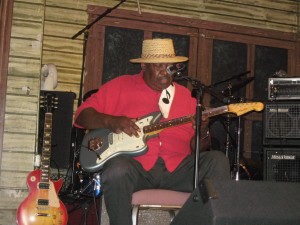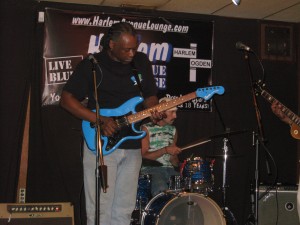This was the third time I’ve seen Magic Slim and the Teardrops this year at Kingston Mines, but it was a special treat, because in the first set Magic Slim played a Fender Jazzmaster. This was his primary guitar on his early recordings, including my favorite album of his, Grand Slam (1982). In his hands (he uses a thumb and a finger pick), the Jazzmaster had a more twangy, stinging tone than does the Les Paul Classic that I’ve see him play before and which he played during the second set. (He doesn’t use effects pedals, but plugs directly into the amp.)
Magic Slim is a master of the shuffle. Many of his songs are based on this fundamental blues rhythm. Born Morris Holt on Aug 7, 1937 in Torrence, Mississippi, Magic Slim is one of the elder statesman of Delta-flavored Chicago blues. He was given his blues moniker by West Side Chicago bluesman, Magic Sam, a Mississippi friend. Magic Slim is no longer slim, but he’s still tall and he definitely still has the magic. There are guitarists who can play faster and with more flash, but very few who can convey the depth of feeling Magic Slim can with seemingly little effort.
At this performance, The Teardrops consisted of Jon McDonald (Fender Stratocaster and vocals), Andre Howard (electric bass) and Brian Jones (drums). They provided a solid rhythmic base for Slim’s singing and playing. During the second set, a trombone player joined the band (I couldn’t catch his name). Additional photos of this event are on Flickr.
I’m already looking forward to more Magic in September when the band returns to Kingston Mines as well as to Buddy Guy’s Legends.

